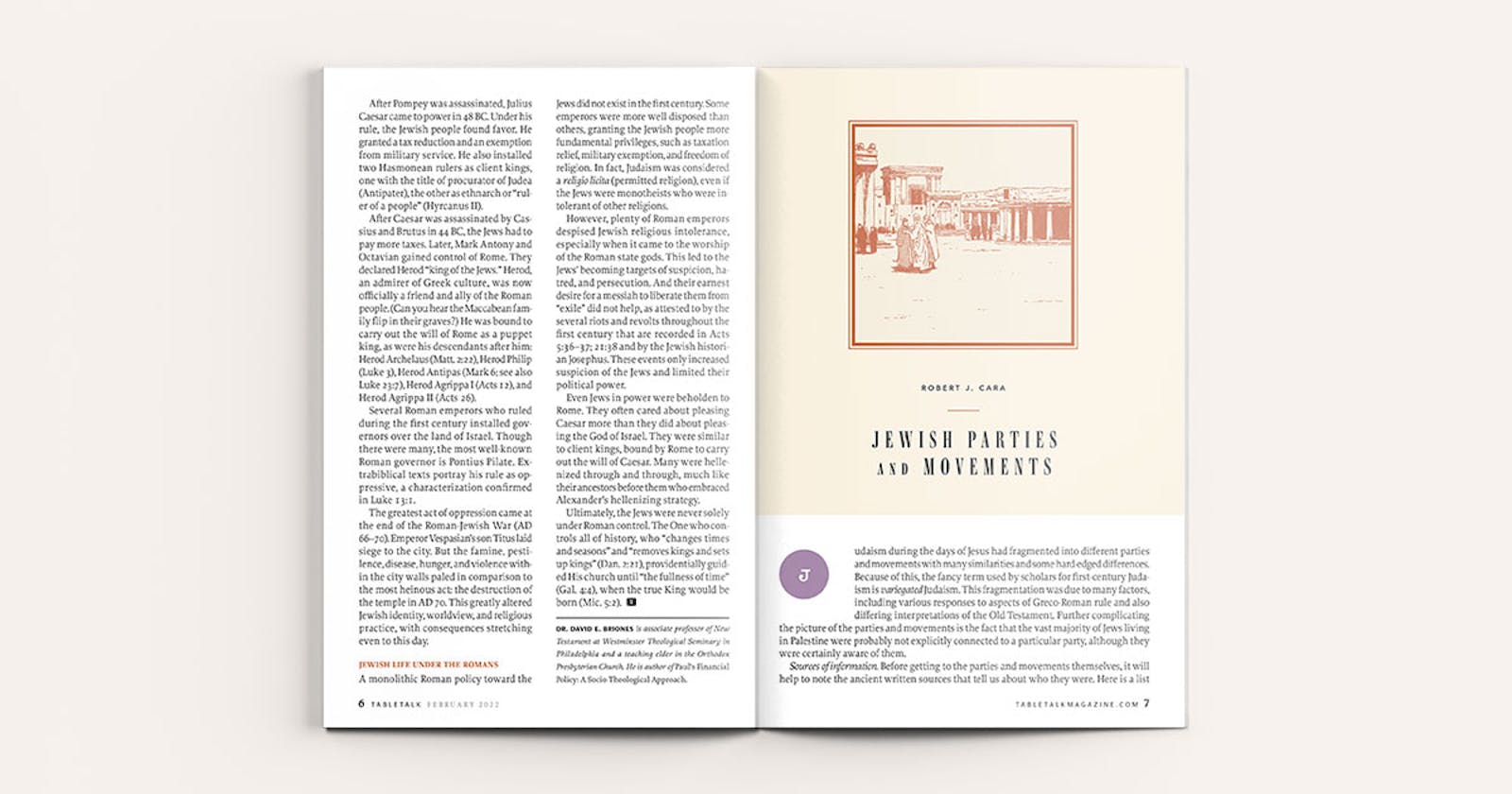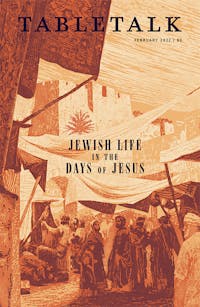
Request your free, three-month trial to Tabletalk magazine. You’ll receive the print issue monthly and gain immediate digital access to decades of archives. This trial is risk-free. No credit card required.
Try Tabletalk NowAlready receive Tabletalk magazine every month?
Verify your email address to gain unlimited access.
Judaism during the days of Jesus had fragmented into different parties and movements with many similarities and some hard-edged differences. Because of this, the fancy term used by scholars for first-century Judaism is variegated Judaism. This fragmentation was due to many factors, including various responses to aspects of Greco-Roman rule and also differing interpretations of the Old Testament. Further complicating the picture of the parties and movements is the fact that the vast majority of Jews living in Palestine were probably not explicitly connected to a particular party, although they were certainly aware of them.
Sources of information. Before getting to the parties and movements themselves, it will help to note the ancient written sources that tell us about who they were. Here is a list with brief descriptions and the dates of the main writings.
- Old Testament Pseudepigrapha (largely Apocalyptic Judaism): 200 BC–AD 200
- Old Testament Apocrypha (history, tales, and wisdom literature): 180 BC–AD 100
- Dead Sea Scrolls (Essenes/Qumran community): 150 BC–AD 68
- Philo (Hellenistic Judaism): AD 10–50
- New Testament: AD 45–95
- Josephus (Pharisee, but mostly nonreligious literature): AD 75–100
- Rabbinic literature (Mishnah to Babylonian Talmud): AD 200–600
- Apostolic and church fathers: AD 100–300
Note that in the list above the dating is fairly broad—that is, the dates extend well before and well after the days of Jesus. Also, for many documents in the Old Testament Pseudepigrapha and Apocrypha, the authors, their locations, and the dates of their writings are simply educated guesses. In addition, the dates of the writings that make up the rabbinic literature are clearly post–New Testament, but these texts certainly have some statements that reflect the reality of life during the days of Jesus. Finally, these writings do include conflicting information. When a source conflicts with the New Testament, I consider the New Testament to be an infallible guide.
Pharisees. The Pharisees included laypeople, lawyers, scribes, and priests. They were not very political and had the explicitly religious goal of having Jews follow the written law of the Old Testament but especially the oral law (the views of the “fathers”). The oral law was the wisdom of various rabbis that purportedly originated from and consisted of implications of oral statements made by Moses. The oral law became very detailed, and in many ways, it functionally took on more authority than the Old Testament. This emphasis on detailed rule-keeping beyond the Old Testament laws produced in many Pharisees a works-salvation view. Pharisees believed in the immortality of the soul and resurrection of the body. Most scholars believe the Pharisee party eventually became the later dominant party in post–New Testament Judaism, represented in the rabbinic literature.
Sadducees. The Sadducees included many priests and members of the aristocracy. Their interest was to support the current functioning temple and the religious and political hierarchy associated with it. As opposed to the Pharisees, they did not believe in the oral law or a bodily resurrection. In fact, they most likely believed that one’s soul ceased to exist at death. They also had a low view of God’s providential control over humans and the world.
Essenes/Qumran community. The Essenes consisted of two variations: one that was male-only and lived in Qumran (near the Dead Sea) and the other that had married families spread throughout Palestine. The Essenes were ascetic in their clothing and food and had many nonbiblical rules that were to be followed. They were at odds with the current priestly line in Jerusalem and considered the temple services invalid. The Essenes considered themselves the true people of God as opposed to other Jews and interpreted Old Testament eschatological (end times) texts as referring to themselves. The community at Qumran housed the Dead Sea Scrolls.
Zealots/Sicarii. The Zealot party wanted to overthrow Roman rule by force. They probably began as a party in the first decade AD and were clearly involved in the fight against the Romans in AD 67–70. The Sicarii were the same or a similar group. They are named after a type of dagger that was used to stealthily murder Romans and some Jews who did not agree with their politics. They also fought the Romans and were the group that died at Masada in AD 74 when a group of Jews made a last stand in the Jewish revolt against Rome.

Herodians. The Herodian party favored the dynasty that was ruling Judea, and more specifically they favored Herod Antipas. They had overlapping concerns with the Sadducees, but otherwise, not much is known.
Samaritans. The Samaritans were well known for believing that proper worship of the Old Testament God should occur at Mount Gerizim (near Samaria), not in Jerusalem. They did not believe in a bodily resurrection and accepted only the first five books of the Old Testament as authoritative. They did believe in a future Mosaic/prophetic/messianic figure. In the days of Jesus, there were significant Jewish-Samaritan tensions. When northern Israel was defeated by the Assyrians (722 BC), non-Jewish people were transplanted into the Samaritan region. Thus, the Samaritans were considered ethnically “half-Jewish” at best by many Jews. Also, the anti-Samaritan Jew John Hyrcanus destroyed the two-hundred-year-old temple at Mount Gerizim in 128 BC.
Palestinian Judaism and Hellenistic Judaism. Scholars use these two terms to refer to the language, culture, and Jewish religious views of two broad movements. Palestinian Judaism refers to Jews who lived primarily in Palestine and whose first language was Aramaic (similar to Hebrew). These Jews were consciously against many of the influences of the Greco-Roman world. Hellenistic Judaism, conversely, refers to Jews whose first language was not Aramaic and whose Scripture was the Septuagint, the Greek translation of the Hebrew Old Testament. They had more interaction with Greco-Roman cultures and religions than the Palestinian Jews. Many Hellenistic Jews, such as the Jewish philosopher Philo, consciously or not, adopted Greek ideas and cultural trends. Confusingly, some Hellenistic-minded Jews lived in Palestine, and some Palestinian-minded Jews lived elsewhere in the Roman Empire.
Apocalyptic Judaism. The Apocalyptic Judaism movement produced apocalyptic literature. Using highly symbolic language, this type of literature predicts the end of the current world, with the writer’s group being saved. Usually, there is a messiah-type figure involved. There are many apocalyptic texts, but there is little knowledge concerning who produced these texts. Probably some were written by the parties we’ve listed and some by isolated groups and individuals about whom we know nothing.
Yes, the Judaism of Jesus’ day was variegated indeed.
